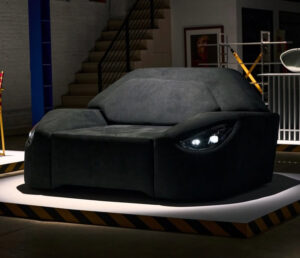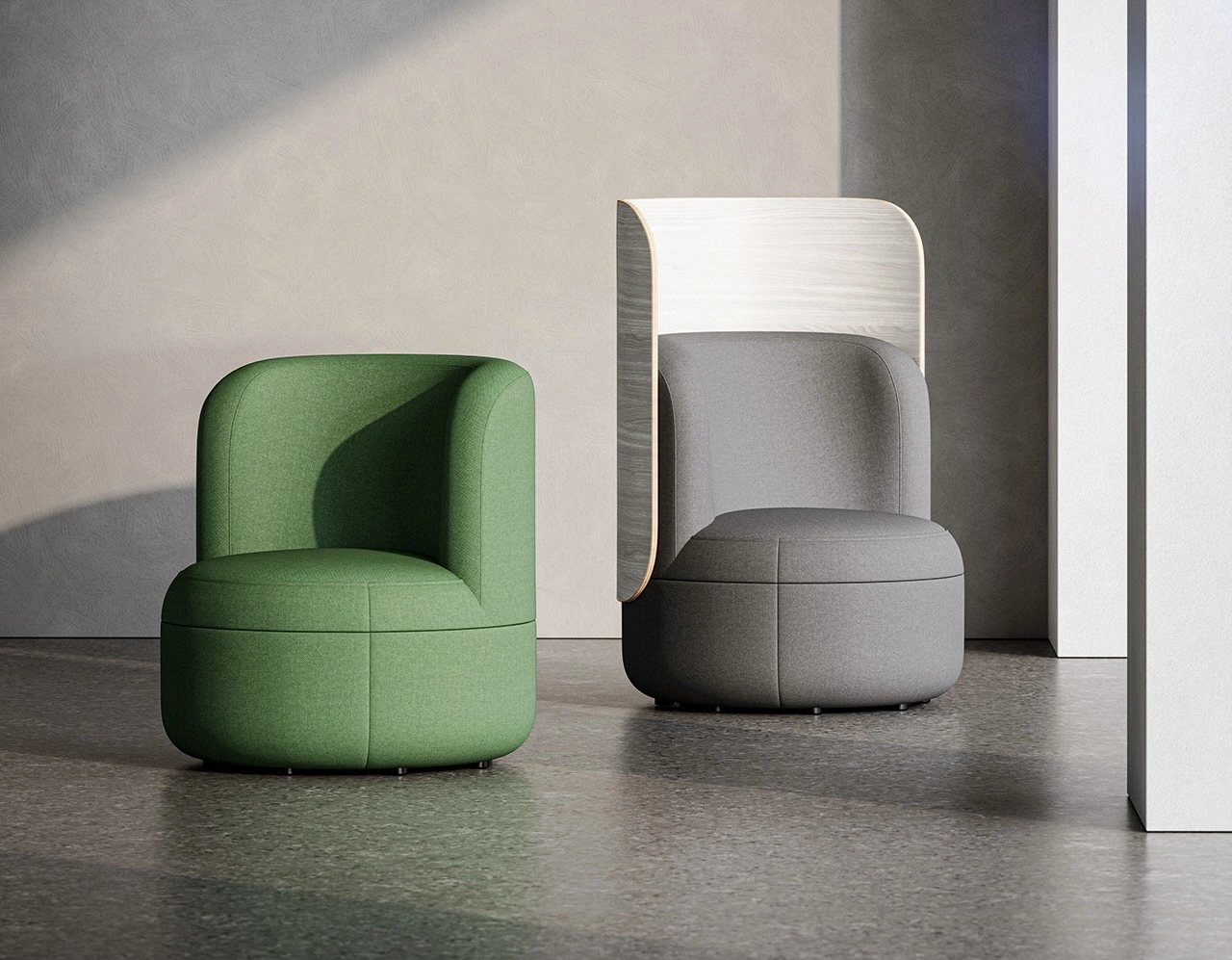
In a city like New York, where skyscrapers compete with ideas and disruption is as much a currency as capital, collaborations like MSCHF x Mercedes-AMG are more than spectacle—they are provocations. Unveiled during NYCxDesign 2025, this unlikely union between the mischief-making art collective and the performance-driven precision of Mercedes-AMG has produced something rare: a furniture collection that feels less like product design and more like performance art. Installed in MSCHF’s industrial Brooklyn studio, the exhibit is as much a critique of design orthodoxy as it is a celebration of material re-use, creative rebellion, and mechanical theater.
Here, turbochargers become table legs, exhaust pipes illuminate rooms, and the aerodynamic language of speed is reprogrammed for the stillness of domestic space. MSCHF, long known for poking fun at art, commerce, and the blurry boundary between them, takes Mercedes-AMG—arguably one of the most serious brands in engineering—and subjects it to a gleeful process of deconstruction and misapplication. The result is not just a collection of objects, but a new kind of dialogue: What happens when luxury performance is no longer mobile? What becomes of purpose when it is unmoored from utility?
From Acceleration to Anchoring: The Radical Heritage
To understand this collaboration, one must first trace its spiritual lineage. MSCHF openly acknowledges the Radical Design movement of the late 1960s and early 1970s as a key point of inspiration. Figures like Ettore Sottsass, Archizoom, and Superstudio didn’t just design furniture; they constructed ideological statements. Their pieces were unmoored from ergonomics and economics, steeped instead in conceptual rebellion. MSCHF’s reinterpretation of AMG components is similarly irreverent. These aren’t chairs meant to conform to the body or lights designed to efficiently illuminate a workspace. They are aesthetic interventions. They ask: Can a trash bin still perform as a waste receptacle if it simultaneously critiques consumerism and the throwaway culture of car culture itself?
The MSCHF x Mercedes-AMG collection answers this with a defiant yes.
Engineering As Ornament
At the heart of the collection is a suite of sculptural pieces that take high-performance automotive engineering and transplant it into the realm of furniture. A front grille, complete with AMG badging, becomes the foundation for a coffee table encased in transparent polycarbonate. Suspended above it, a rear spoiler transformed into a light fixture glows with eerie precision. There’s a dining chair built from bucket seat fragments and carbon fiber panels, its contours still coded with the ergonomics of racing. These aren’t simply found-object sculptures—they are deliberate, crafted acts of distortion. Every element retains enough of its mechanical DNA to evoke the origin of speed, but through MSCHF’s lens, speed is stalled, domesticated, and aestheticized.
The act of converting an exhaust system into a lamp—seen in their “Downpipe Luminaire” piece—is emblematic of this recontextualization. The object, once responsible for expelling spent fuel, now serves to distribute light. It speaks to transformation, but also to inversion: what once pointed toward motion now anchors a moment. It’s part readymade, part satire, and part tribute.
Domesticating the Machine
MSCHF’s core sensibility has always lived somewhere between viral subversion and high-art critique. Their Jesus Shoes (Nike Air Max 97s filled with holy water), their “Birkinstocks” (Birkenstocks made from dismantled Hermès Birkins), and their infamous “Big Red Boots” turned absurdity into a material. With Mercedes-AMG, the tone is more reverent, but only slightly. By dragging AMG performance into the home, MSCHF is performing a double act: elevating car parts into collectible art while also reducing their original function to decorative absurdity.
A V8 engine block now serves as the base for a loveseat. The pistons remain visible, frozen mid-compression, as if to remind viewers that beneath the upholstery lies a machine built for violence. Elsewhere, air intake manifolds are reimagined as sculptural coat racks, and chrome-dipped wheel rims act as seating surfaces, echoing both the slick aesthetics of car culture and the discomfort of post-industrial brutalism.
Even the bins—cast from carbon ceramic brake rotors—are meta: they suggest disposal, but they’re virtually indestructible. This contradiction is the point. Like Radical Design’s “non-functional function,” MSCHF’s furniture doesn’t just fill a room—it comments on why the room exists at all.
From Studio to Streetwear: The Capsule Collection
Parallel to the furniture, MSCHF and Mercedes-AMG also unveiled a limited-edition capsule collection: a distilled expression of the same themes in wearable form. This line includes racing jackets reworked with asymmetrical stitching, gloves stitched with reverse AMG emblems, and overdyed mechanic shirts that bear cryptic slogans like “Idle Forever” and “Drive Until Still.”
This wearables line operates on the logic of contrast. Where AMG typically promotes cutting-edge aerodynamic performance, MSCHF responds with the static, the absurd, the un-driveable. Their garments are less uniform and more archive — somewhere between pit crew cosplay and post-apocalyptic workwear. This intentional visual discord makes the collection stand out within both streetwear and motorsport merchandise spheres. Nothing fits quite right, which is precisely the point.
As MSCHF co-founder Daniel Greenberg described during the exhibition’s media preview, “We wanted to ask: if Mercedes-AMG is the perfect expression of performance, what happens when we rip performance out of the equation?”
Design as Satirical Cartography
In a broader context, this exhibition doesn’t just revisit the Radical Design ethos; it modernizes it. Where Superstudio’s furniture was a rejection of bourgeois consumerism, MSCHF’s version is a parody of fetishistic materialism. It speaks in the language of luxury—carbon fiber, brushed aluminum, limited runs—but uses it to critique the very idea of prestige.
There’s an undercurrent of sustainability here too, though not in the earnest, greenwashing sense often found in product launches. Instead, MSCHF’s sustainability comes via repurposing, humor, and deliberate dysfunction. No new materials were created for the collection—all pieces are built from retired AMG components or surplus parts. In that sense, it’s an inversion of fast furniture’s obsolescence: here, obsolescence is the point of origin.
The Showroom as Stage
Staged in MSCHF’s Brooklyn studio from May 14–17, the exhibit itself is an experience in spatial mischief. Visitors enter a space that echoes both a car garage and a contemporary gallery. Fluorescent lights reflect off polished chrome. Tires rest against walls like sculptures. A soundtrack of revving engines and ambient machine noise loops quietly in the background. It is immersive but never overwhelming—tongue-in-cheek yet curated with undeniable precision.
Every piece in the exhibition is functional, but barely. The lights glow dimly. The seats creak with intentional imbalance. The tables appear as though they could collapse under a single espresso cup. This is not furniture for use. It is furniture for contemplation—a distorted mirror held up to the culture of luxury engineering and domestic consumption.
Between Irony and Reverence
MSCHF walks a fine line in this collaboration. While the brand’s past work has been deeply cynical, there’s something almost reverent about their treatment of Mercedes-AMG components. Yes, the works mock the fetishization of cars, but they also showcase an undeniable appreciation for craftsmanship. The way each turbocharger is polished, the preserved texture of carbon fiber, the exact balance of a spoiler lamp—it suggests love masquerading as mischief.
Mercedes-AMG, for its part, has taken an uncharacteristically bold step. Known for engineering precision and elite motorsport heritage, AMG aligning with MSCHF is a signal of brand maturity—a willingness to allow reinterpretation, even mockery, as a form of legacy expansion. This isn’t just about marketing to a younger audience; it’s about embracing the cultural afterlives of luxury objects.
Toward A Post-Functional Future
In many ways, the MSCHF x Mercedes-AMG furniture collection doesn’t belong in a living room. It belongs in a museum, a design biennale, or maybe even a garage-turned-theater. It exists in a post-functional space, where design is no longer about solving a problem but about interrogating it.
This is what makes the connection so compelling. It’s not just that MSCHF has turned AMG parts into furniture. It’s that they’ve turned furniture into a conversation. One that questions value, utility, aspiration, and the limits of industrial design. One that leaves visitors wondering not “would I sit in that?” but rather “why do I expect to?”
And that, more than anything, is the legacy of Radical Design. Not objects for comfort, but artifacts of provocation. MSCHF didn’t just build chairs. They built arguments.
No comments yet.









